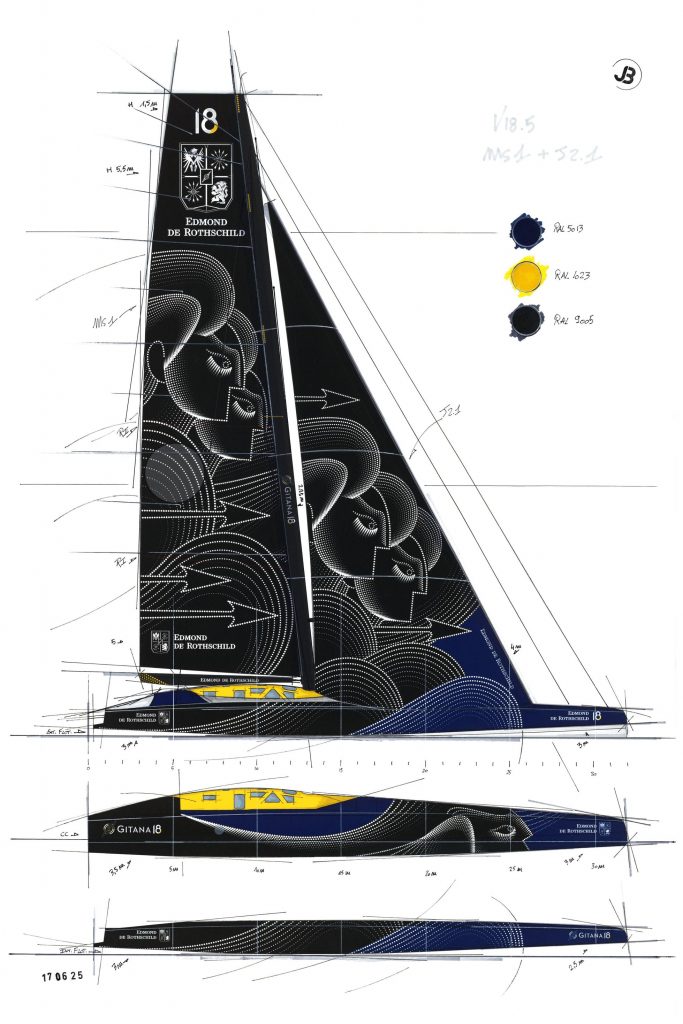Eight years ago in Paris I stopped into the Palais de Tokyo modern and contemporary art building to view new artwork revealed for the Gitana 17—the then latest Maxi Edmond de Rothschild racing trimaran. There, I spoke with Los Angeles based artist Cleon Paterson who had created striking imagery for the sail and hull. I later wrote about this art in a piece related to modern sailing.
Time has raced by.
In September this year the Gitana 17 will be replaced with Gitana 18, also known as the Maxi Edmond de Rothschild, a next generation trimaran. This new craft will be emblazoned with fresh art work.
The 105 feet (32 meter) long and over 75 feet (23 meter) wide trimaran includes vessel and sail surface area of 21,500 square feet (2,000 square meters). The artwork for Gitana 18 was created by brothers Florian and Michael Quistrebert, and will be implemented onto the craft and sails by Jean-Baptiste Epron.
Images show five faces—representing Arianne de Rothschild and her four daughters, to whom Arianne dedicates this boat. The artwork uses black and white contrast, or chiaroscuro, as well as sfumato shading. As with Gitana 17, five arrows in the design represent the five branches of the Rothschild family.
The Quistrebert brothers were born in Nantes and graduated from the Ecole des Beaux Arts in that city (Nantes is also birthplace to Jules Vernes, author of the fictional nautical exploration book Twenty Thousand Leagues Under the Sea, and namesake of the renowned sailing race—Jules Verne Trophy). The brothers now live in Amsterdam and Paris and produce art that can be dazzlingly kaleidoscopic with clean, balanced geometrical tension; some is as compellingly detailed as works (and worlds) created by M.C. Escher. Their multi-media exhibits have in the past included paste on burlap, iridescent paint and illumination by LEDs.
Construction of Gitana 18 began with an announcement in 2023. CDK Technologies in Lorient, working with naval architect Guillaume Verdier, is crafting the latest maxi trimaran iteration since Gitana 17 was launched in July, 2017. According to Sail-World, eight full time staff are dedicated to this work that requires 50,000 hours of study—coordinated by design team leader Sébastien Sainson. That is more than 40% more study time than was required for Gitana 17. The craft is scheduled for completion by the end of September. Details are confidential, but the overall difference from previous models? This craft is designed to raise out of water and ‘fly’ through air even earlier than its predecessor, and should be capable of maintaining performance for longer distances over rough seas.
Eight years ago sail racing was transforming from a naval to an essentially aerial sport. Today that change is complete. Sail racing has radically altered due to materials technology, a greater grasp of hydrodynamic subtleties and advances in digital design. The adoption of foils shoves the bulk of race craft from sea to sky, where aerial friction is puny compared to the friction of water. This allows boats to race far faster. That’s because water is more than 800 times denser than air, and that density is literally a drag. Think of the slog of walking through water in a swimming pool compared to the breeze of sauntering across an adjacent deck.
Other advances in technology in the past eight years include better understanding of carbon fiber and foam sandwich construction to reduce weight and improve hull strength, as well as better cockpit design and improvements to computational fluid dynamics.
Technology is also advancing in the world of art, related to materials and exhibition capabilities. Fortunately, artistic inspiration and vision remain pleasingly unpredictable.

